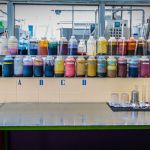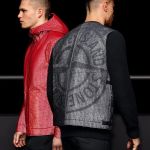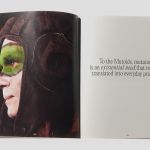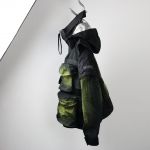
A Focus On Technical Design Brand NEMEN
A True Story ‘Made in Italy’
March 21st, 2019
In a world where the pace of fashion is moving ever faster, hype along with the ability to maneuver through the motions of the fashion game often dictate a brand’s success more than the product that is actually on offer. What should be in greater focus, is that of its craft. Coupled with the pursuit of pushing an art form forward in an ever-evolving state of existence, true art and true fashion starts with the fundamentals: the yarn, the fabric, the garment dyeing process, the complete knowledge of which will ultimately dictate your understanding of any finished piece. Enter NEMEN®, the Italian made brand that has existed rather quietly in the peripheries of utilitarian and technically focused clothing. Without making much noise, the brand has honed its craft to a level of superiority that is becoming rarer and rarer these days. By gathering some of the most important and visionary characters in contemporary utilitarian fashion, entwined deeply within the helix of its DNA, an amazing story is told. NEMEN® very much defines the excellence that lies behind a true meaning of Made in Italy.
![]()
NEMEN® Studio

NEMEN® Studio
An Introduction
It was a crisp early spring day when we first entered the NEMEN® studio in Milan. Contained in what can most readily be described as an open plan, two story house, upon entering one is greeted by two long rows along the side wall of what, founder and CEO Leonardo Fasolo, is quick to identify as the archive. It is hard to not want to dive straight in and a quick flip through the rows, is a desire I am simply too weak to resist. Hung in a relatively chronological order, the tips of my fingers get the first spun tales of how the collections have evolved over time here at NEMEN®. How a Nylon yarn ended up with its bonded relationship to Polyurethane to create a fabric feel that most have yet to experience. We’re getting a little ahead of ourselves here though.
After the two rows of the archive, we enter on to the main floor if you will, where clearly the principal space of creation presents itself- the sewing and cutting floor where Leonardo’s sister Caterina is busy working on a prototype. A cluster of large vertical fluorescent lights bathes the space in their naked glow, giving small clues to the many experiments that have been conducted here over time. Leonardo notices my eyes pause at a piece which he subsequently then grabs and explains that the intricate pattern I’m mesmerized by was created by spraying a micro Polyurethane yarn onto the garment, that it is actually tactile fibers and not just paint which it resembles.

Textile Samples
The Story
Going back to where things started, Leo, like many of his generation who grew up in the ’80s and ’90s, was exposed to the blossoming age of street culture and was immediately enamored by it. His mother was a graphic designer and he grew up playing with alphabet stencils and Letraset design tools. When the first wave of streetwear aesthetics started arriving in Italy via brands such as Stüssy and various band merchandise, Leo, already at the age of around 10 years old, started experimenting in making his own t-shirt designs. Later, graffiti become his principal interest and his passion for design started to bloom. In his late teens he was employed in a factory working with electrical transformers, opening his eyes to the more technical aesthetics of the engineering world paired with the utilitarian designs of workwear.

Feeling ultimately unfulfilled, he decided to move to Milan and started to study fashion at the IED, Istituto Europeo di Design. Here Leonardo had the first of a series of chance encounters that would come to change his life, starting with none other than Stone Island’s, Carlo Rivetti being his teacher. The two formed a bond and upon graduating, he started working straight away at Stone Island in 2005, where his education into garment dyeing techniques and textiles was refined further. At Stone Island Leo met Paul Harvey, and from here his design language started to take on new and exciting shape. Leonardo still considers Paul Harvey to be one of the most talented designers of the last three decades. After four years, Harvey decided to retire from fashion for a time and Leo then also felt it was time to move on, first going to work at CP Company, and thereafter coming to work for the next big inspiration of his life, the Massimo Osti archive. Together with Massimo Osti’s son, Lorenzo Osti, a period of deep immersion into Osti’s work began. The impact of Osti’s design approach on the whole fashion world and beyond can to this day not be understated, a true translator in making art and garment production a unified language.
NEMEN®
In 2012 Leonardo felt it was time to put his vast experience into practice for himself and NEMEN® was founded. A partnership was founded with Finest Cloth, a design studio specializing in Sportswear clothing experimenting with research and the testing of fabric treatments, and his sister Caterina, both who to this day still work at NEMEN®. From the very beginning, the principles were set, the approach was about creating the best possible collections with experimentation at its heart. At first, all the investment went straight into the products, which meant for the first few years NEMEN® operated out of an underground garage to make sure there was never any compromises when it came to the products. Though deciding to leave the garage setting after just a couple of years to have a more creative surrounding to work in, their approach was cemented in those early years. Focusing on the studying of the prototypes, creating everything from the idea to the pattern, to the first manifestations, in-house, this becoming the method of translating their ideas into products.

Leonardo Fasolo, founder and CEO
Compared to other brands where you bring the design, the sketches and all the information to the table and then having to wait a month for a prototype to be made, NEMEN®, much like having their own lab, could experiment wider and deeper. Sometimes even without designing, just by talking and creating, and thereby being able to realize a prototype much, much faster, and much closer to a haute couture approach than that of sportswear. The experimentation of course also led to what you could call mistakes. But mistakes, or let us say the unexpected, is sometimes what leads to the most interesting results, thus one of the best resources becomes the process itself and the main reason why NEMEN® exists: to constantly push the research, in the true sense of the word, and the products forward to new and unknown territories of existence.
The Archive ![]()
Rusted effect / Imperial Camouflage / Triple Tie-dye
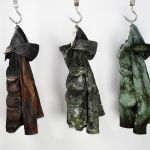
Rusted effect / Imperial Camouflage / Triple Tie-dye
To help tell their story, I had asked Leonardo to select a few standout pieces from the archive that did just that. No small task I later discovered as I started to look through the hundreds of pieces that lined the walls of the archive, but we came to the conclusion to have four different themed sets which included some standout pieces within each. For the first set we wanted to focus on evolution, by taking a returning signature NEMEN® jacket and showing the manifestation that the various different dyeing techniques had yielded across different seasons. The Multi-Pocket Smock had gone through 3 different life cycles, the first was a Rusted effect, a treatment individually done by hand, dipping, spraying, and then dyeing the garment to simulate the oxidation of metal. The second was an Imperial Camouflage treatment. During the First World War, camouflage was created by hand-painting and dipping garments one by one. Utilizing this old technique on modern nylon fabrics, giving an iridescent effect and thereby achieving a completely new aesthetic with a different sense of authenticity. The third utilized a Tie-Dye effect on Nylon to achieve a mineral effect, creating a new type of military camouflage.
ACR_NMN®
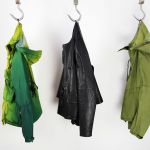
Gradient Jacket / 3L Leather Jacket / 3L Shell Jacket
The second set was dedicated to a milestone in the form of the collaboration that NEMEN® had with Errolson Hugh and which had spawned some truly iconic pieces. While at Stone Island, through the Shadow Project sub-line, Leo had met Hugh, who co-founded another pinnacle brand within techwear, ACRONYM®. Finding an immediate kinship in their approach and joint understanding of the technical aspects of textile development and garment dyeing, the two cemented a friendship that, starting in 2015, would spawn three joint collaborations between them. Combining their different skillsets into a singular vision, the first SS15 collection saw a 3L jacket design of Hugh’s meet the dyeing prowess of Leonardo to create a range of military inspired green dyed t-shirts, sweaters, and Hard-Shell jackets. In their second round, the textile focus shifted to Nylon bonded with Multiprene, in a thermally insulating foam jacket and the definitive 3 Layer Leather Jacket, which used the highest quality calf leather, washed and bonded with a Japanese Komatsu membrane. In their hereto last collaboration NEMEN® and ACRONYM® created their most standout range to date, a Hard Shell Object Dyed Jacket that came in 6 different 2-tone gradient colorways, with an amazing handmade dyeing technique, where each piece faded cleanly into their respective two tones of color. The collection became a benchmark within the word of technical fashion, standing as a seminal example from each of the brands until this day.
Prototypes
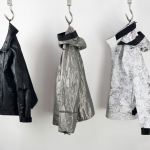
Monofilament nylon 60din Garment Dyed / Silver PU cover / PU Sprayed
For the third, we decided to show off the unseen engine that lay beneath the bonnet of the NEMEN® machine, experimentation. Showing off a few of the incredible prototypes that had often only been created in a single existing edition, which so very well showed the limits that they were always aiming to push. The first such example was a Fibre Optic Jacket (pictured below), a prototype design which incorporated Fibre Optic light cables that emanated from the bottom and from the hood of the jacket, to light up the jacket along the fibers within the translucent layers of the jacket itself. The end result being comparable to the sight of anyone who's seen glow worms spin their bioluminescent webs as they descend down upon them in the night.
We then brought out two jackets that were made with fabric Monofilament nylon 60din with a Silver Polyurethane cover on the back and garment dyed to achieve an iridescent effect. Lastly came the jacket that had first caught my eye, the Guard jacket with randomly micro sprayed Polyurethane on the whole surface of the jacket. The idea was to create a sort of unwoven layer on top of the fabric to make a graphic pattern with real functionality, increasing the performance of the fabric.
SS_19
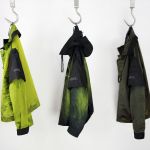
Revolt Jacket / Acid Dye Guard Jacket / Marking Jacket
Finally, we wanted to arrive at the present with a few gems from their just released SS_19 collection. The Acid Dyed Guard Jacket took center stage, in many ways this season’s definitive piece. It implements a new Acid Dye treatment, where each garment is handmade and hand sprayed, making every finished piece individually unique. Next to it hung the Revolt jacket that with its Nylon Monofilament bonded with a Polyurethane lamination had come to acquire a dazzling lagoon green shimmer finish as the afternoon light hit it from the window. The same treated textile had been used for the Marking Jacket, this time resulting in a finish that resembled the metallic glint of a scarab beetle's shell.
Made in Italy
NEMEN® operates very much on the level of the tactile. Having been well aware of the brand for a few years and having also tried on a few pieces here and there, my understanding of the brand instantly expanded exponentially when going along the archive and touching the pieces. It is a level of quality that really needs to be felt to be completely understood and is perhaps why NEMEN® is yet to have their big breakthrough. I consider myself more than a little well versed at this point in my life when it comes to garments and textiles, having tried, touched, and even owning a few brands that really are considered the best of the best. Yet feeling what NEMEN® can do with a fabric such as Nylon is nothing short of remarkable.
When asked to talk more about their products and the often asked question of why NEMEN® operates within the price brackets they do, the answer is really fairly straight forward. To produce the type of products they do, they have to create them in Italy, because there simply is no other place on earth, apart from perhaps Japan, that can create some of these fabrics with the level of production adaptability they require. Garment dyeing technique is a tricky art, with a great many things that need to be done right before even starting to dye.
You have to factor in fabric shrinkage, the individual fabric’s color reaction, and on top of that almost always asking for things to be done that have never been done before. Another factor is quantity, it isn't hard to imagine that creating an experimental batch of apparel in small quantities isn’t something most textile producers will jump at, but again it’s an innately Italian perspective that makes this possible. Italy has this unique perspective of not, first and foremost, being preoccupied with whether something makes complete sense economically or quantitatively, as long as the end result is the highest quality of a product. It’s about the taste. Like with the making of their luxury cars, it is not about big sales or big numbers, it’s about the value of what you create and that’s what the true essence of Made in Italy is, and what very much lies at the heart of NEMEN®. They want to represent Italy through their products and when you live in and come from a heritage of a forward-looking perspective that allows you to do things that no other place can, they feel it is their proud duty to do so.
![]()
The Yarn
A Garment's Life and Beyond

The Yarn
An interesting fact about garment dyeing is that if you use the very best quality fibers and yarn in the dyeing process, if done well, it will only increase the quality of the fabric. Like realizing its true potential, Leo likens this process to giving a soul to the fabric, like breathing life into a garment which in turn becomes an emotional process for him and is another aspect of why going that extra mile is ultimately more rewarding when you end up with something very real and living in your hands.

Garment Dye Process
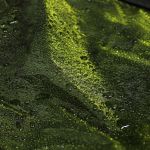
Treatment Detail
The NEMEN® SS_19 collection is available now via the NEMEN® site






















































